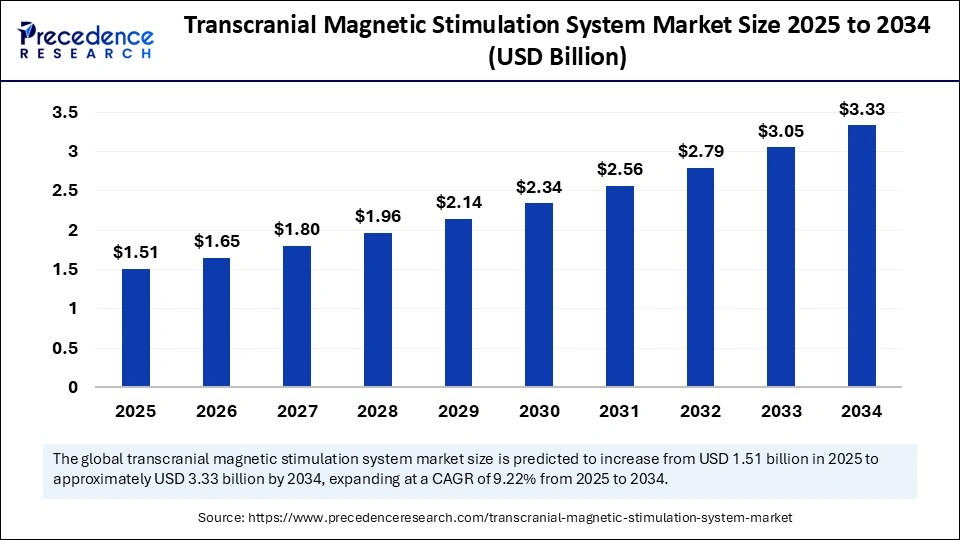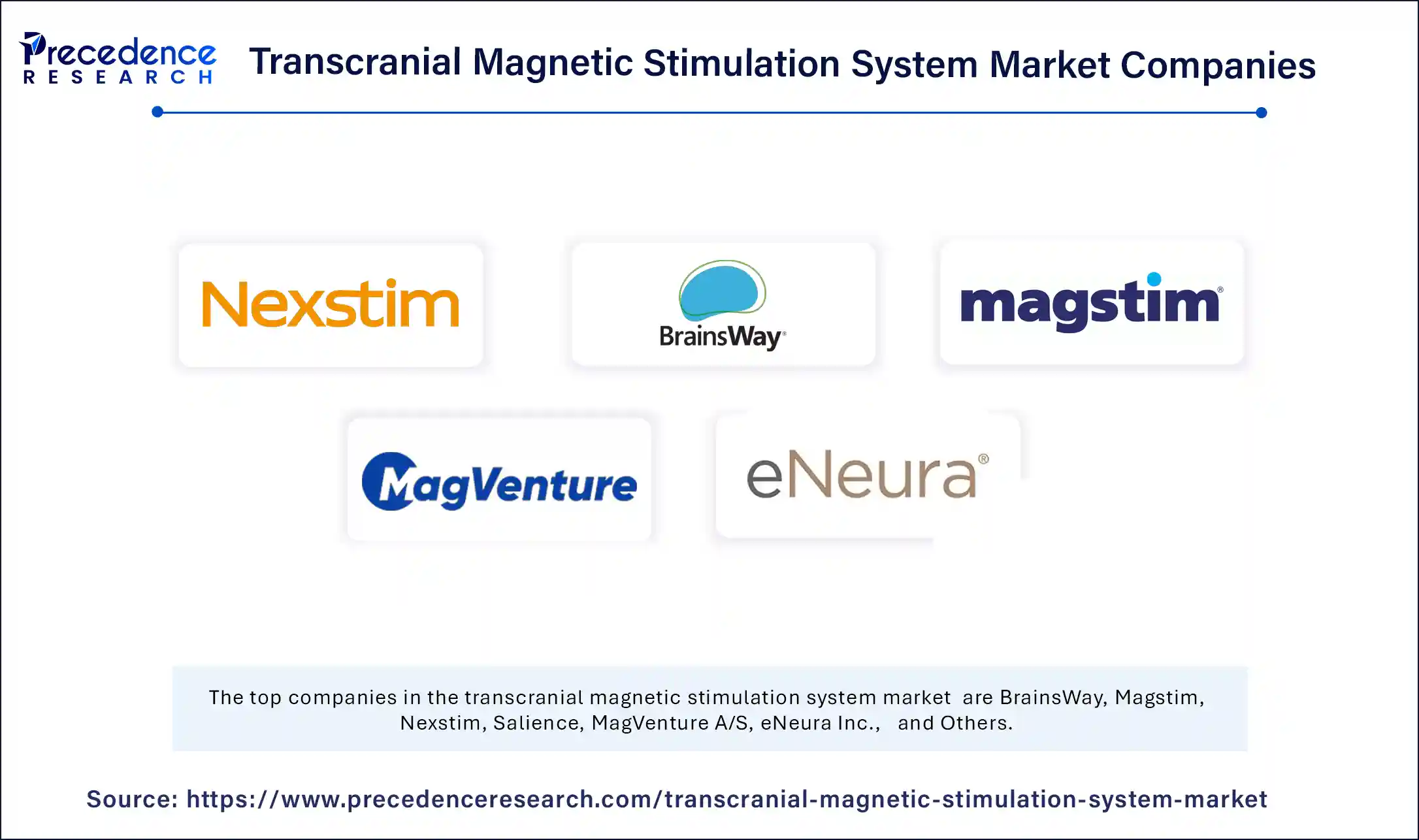
Transcranial Magnetic Stimulation System Market Key Highlights
-
North America accounted for the largest revenue share of 33% in 2024.
-
Asia Pacific is projected to grow at the fastest CAGR of 10.3% during the forecast period.
-
By type, the repetitive transcranial magnetic stimulation segment held the largest revenue share of 40% in 2024.
-
The deep transcranial magnetic stimulation segment is expected to grow at the fastest CAGR of 9.64% in the coming years.
-
By application, the Alzheimer’s disease segment contributed the highest revenue share of 43% in 2024.
-
The depression segment is anticipated to grow at the fastest CAGR in the upcoming period.
-
By age group, the adults segment dominated the market with a 60% revenue share in 2024.
-
The children segment is projected to grow at a significant CAGR of 9.52% from 2025 to 2034.
Role of AI in Transcranial Magnetic Stimulation (TMS) System Market
Artificial Intelligence (AI) is increasingly shaping the Transcranial Magnetic Stimulation (TMS) System Market by enhancing treatment precision, improving patient outcomes, and optimizing clinical workflows. One of the most significant applications of AI in this field is in personalized treatment planning. AI algorithms can analyze patient-specific data—such as neuroimaging results, clinical history, and response to previous treatments—to tailor stimulation protocols. This level of customization helps in identifying the optimal stimulation targets and parameters, improving the efficacy of TMS therapy for conditions like depression, anxiety, and neurological disorders.
Additionally, AI plays a key role in real-time monitoring and feedback mechanisms during TMS sessions. Machine learning models can detect subtle patterns in brain activity and patient responses, allowing for dynamic adjustments to stimulation intensity and frequency. This reduces variability in treatment outcomes and enhances safety. AI also supports predictive analytics to forecast treatment responsiveness, helping clinicians make more informed decisions about whether TMS is the right intervention for a particular patient.
Furthermore, AI-driven data analytics streamline administrative tasks such as scheduling, patient tracking, and outcome reporting, improving overall clinic efficiency. As AI technologies continue to advance, they are expected to play an even more integral role in expanding the clinical applications of TMS and in making treatments more accessible and effective across diverse patient populations.
Transcranial Magnetic Stimulation (TMS) System: Overview
A Transcranial Magnetic Stimulation (TMS) system is a non-invasive neurostimulation device used primarily to treat neurological and psychiatric conditions by stimulating specific regions of the brain. The system delivers magnetic pulses through a coil placed on the scalp, which induces electrical currents in the targeted brain tissue. This helps modulate neural activity and is most commonly used in the treatment of major depressive disorder (MDD), especially in patients who do not respond to traditional antidepressants.
TMS systems are gaining widespread acceptance due to their non-invasive nature, minimal side effects, and effectiveness in improving mood and cognitive functions. They are also being studied and used for other conditions such as anxiety disorders, obsessive-compulsive disorder (OCD), post-traumatic stress disorder (PTSD), and chronic pain. Advanced systems offer repetitive TMS (rTMS) and deep TMS (dTMS), providing clinicians with flexible and more targeted therapeutic options.
Components and Functionality
-
Stimulator Unit: Generates the magnetic pulses.
-
Coil (usually figure-8 or H-coil): Placed on the patient’s scalp to focus the magnetic field.
-
Positioning System: Ensures accurate and repeatable coil placement over the brain’s target region.
-
User Interface & Software: Allows healthcare providers to set parameters like intensity, frequency, and pulse duration.
Transcranial Magnetic Stimulation System: Key Growth Drivers
The Transcranial Magnetic Stimulation (TMS) system market is experiencing notable growth, primarily fueled by the increasing prevalence of neurological and psychiatric disorders such as depression, Alzheimer’s, Parkinson’s disease, epilepsy, OCD, and anxiety. Major depressive disorder and Alzheimer’s are among the leading applications, with depression treatment projected to grow at a faster pace due to rising mental health awareness and a growing demand for non-invasive, drug-free alternatives. TMS systems are particularly effective for treatment-resistant patients, offering benefits with minimal side effects, which has led to greater acceptance among healthcare providers and patients alike.
Technological advancements are also playing a pivotal role in driving market expansion. Innovations such as deep TMS, navigated TMS, and image-guided targeting have significantly improved treatment accuracy, depth, and patient outcomes. The development of personalized and precision-based stimulation approaches is broadening the range of clinical indications. Additionally, favorable reimbursement policies, increased regulatory approvals, and expanding insurance coverage are making TMS more accessible to a wider population. Geographic growth in regions like North America, Europe, and Asia-Pacific, along with the establishment of new clinical centers and ongoing research trials, continues to boost adoption and enhance the overall market outlook.
Get this report to explore global market size, share, CAGR, and trends, featuring detailed segmental analysis and an insightful competitive landscape overview @ https://www.precedenceresearch.com/sample/6163
Market Scope
| Report Coverage | Details |
| Market Size by 2034 | USD 3.33 Billion |
| Market Size in 2025 | USD 1.51 Billion |
| Market Size in 2024 | USD 1.38 Billion |
| Market Growth Rate from 2025 to 2034 | CAGR of 9.22% |
| Dominating Region | North America |
| Fastest Growing Region | Asia Pacific |
| Base Year | 2024 |
| Forecast Period | 2025 to 2034 |
| Segments Covered | Type, Application, Age Group, and Region |
| Regions Covered | North America, Europe, Asia-Pacific, Latin America, and Middle East & Africa |
Transcranial Magnetic Stimulation System Market Dynamics
Market Drivers
The growing global prevalence of neurological and psychiatric disorders, such as major depressive disorder (MDD), anxiety, and obsessive-compulsive disorder (OCD), is a primary driver of the transcranial magnetic stimulation (TMS) system market. As awareness about mental health continues to rise, the demand for non-invasive and effective treatment options like TMS has surged.
Traditional pharmacological treatments often come with significant side effects or limited effectiveness, prompting both clinicians and patients to explore alternative modalities. Furthermore, the increasing adoption of TMS in research institutions and clinical settings has expanded its credibility and application beyond depression to include conditions such as PTSD, schizophrenia, and chronic pain. The supportive reimbursement policies in developed countries, especially the U.S., further incentivize healthcare providers to incorporate TMS therapies into their practices, thereby accelerating market growth.
Technological advancements in TMS systems have significantly enhanced treatment precision, patient comfort, and ease of use. Innovations such as deep transcranial magnetic stimulation (dTMS) allow clinicians to target deeper brain regions with improved accuracy, expanding therapeutic possibilities. Portable and user-friendly systems have also become more accessible, enabling outpatient care and even home-based treatment trials. These technological strides not only improve clinical outcomes but also broaden the potential user base by making treatments more accessible and less intimidating. With a growing focus on personalized and non-invasive neuromodulation therapies, TMS is increasingly positioned as a cornerstone of modern mental health and neurorehabilitation services.
Market Opportunities
One of the major opportunities in the TMS system market lies in the expanding applications of the technology across diverse neurological and psychological conditions. Emerging studies and clinical trials continue to explore the efficacy of TMS in treating Alzheimer’s disease, Parkinson’s disease, chronic pain syndromes, and substance use disorders. As regulatory bodies approve more of these expanded indications, the market is likely to witness a significant uptick in demand. Moreover, the convergence of TMS with digital health technologies, including AI and real-time brain monitoring systems, is creating new avenues for precision-targeted therapies. This integration can result in more effective treatment plans, shorter sessions, and better patient outcomes.
There is also a growing opportunity for TMS providers in emerging markets such as Asia-Pacific, Latin America, and the Middle East. As healthcare infrastructure improves and mental health awareness spreads across these regions, the demand for advanced therapeutic tools is increasing. Local governments and private players are investing in modernizing healthcare services, and international collaborations are enhancing access to innovative technologies like TMS. Additionally, the rising number of mental health startups and telemedicine platforms that integrate or refer patients to TMS therapy creates a conducive ecosystem for market expansion.
Market Challenges
Despite its promising benefits, the transcranial magnetic stimulation system market faces several challenges that could hinder widespread adoption. A key barrier is the high cost associated with TMS equipment and therapy sessions, which limits its affordability, especially in low- and middle-income countries. While reimbursement policies in some regions support TMS treatment, coverage remains inconsistent globally, and many insurance providers still consider it experimental for certain conditions. This lack of uniform financial support can deter healthcare providers and patients from opting for TMS therapy.
Another challenge is the limited awareness and availability of trained professionals capable of administering TMS. Although TMS is non-invasive, it requires specialized knowledge for precise targeting and effective treatment outcomes. A shortage of skilled practitioners, particularly outside major urban centers, can restrict the reach of these systems. Additionally, patient adherence to treatment regimens, which often require multiple sessions over several weeks, remains a concern. Skepticism among some clinicians regarding the long-term effectiveness of TMS further complicates its integration into standard care pathways.
Regional Outlook
North America currently dominates the transcranial magnetic stimulation system market, accounting for the largest share in 2024. This strong position is attributed to advanced healthcare infrastructure, widespread mental health awareness, favorable reimbursement frameworks, and a high concentration of key market players and research institutions. The U.S., in particular, has seen significant adoption of TMS therapy, both in academic centers and private clinics, driven by FDA approvals for multiple indications and growing insurance coverage.
Europe follows closely, with countries like Germany, France, and the UK leading in TMS adoption due to proactive mental health initiatives and public healthcare funding. The region also benefits from strong regulatory support and a well-established network of neurological research facilities.
Asia-Pacific is anticipated to grow at the fastest compound annual growth rate (CAGR) during the forecast period, driven by rising mental health issues, increasing healthcare expenditure, and growing awareness of non-invasive treatment options. Countries like China, India, Japan, and South Korea are witnessing a gradual shift toward modern mental health interventions, making the region an emerging hotspot for TMS system manufacturers and service providers.
Meanwhile, Latin America and the Middle East & Africa present untapped potential, though market growth is slower due to infrastructural limitations and affordability concerns. However, rising investment in private healthcare and increasing partnerships with global players are expected to gradually enhance market penetration in these regions.
Transcranial Magnetic Stimulation System Market Companies

Segments Covered in the Report
By Type
- Deep Transcranial Magnetic Stimulation
- Repetitive Transcranial Magnetic Stimulation
- Others
By Application
- Alzheimer’s Disease
- Depression
- Parkinson’s Disease
- Epilepsy
- Others
By Age Group
- Adults
- Children
By Region
- North America
- Europe
- Asia Pacific
- Latin America
- Middle East and Africa
Also Read: Service Provider Network Infrastructure Market
Source: https://www.precedenceresearch.com/transcranial-magnetic-stimulation-system-market
You can place an order or ask any questions, please feel free to contact at sales@precedenceresearch.com|+1 804 441 9344